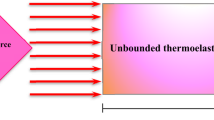Abstract
Of interest here are dynamic thermoelastic problems influenced by second sound effects. In this regard, the effect of the so called ‘heat waves’ on solid continua is investigated employing a ‘unified’ explicit computational architecture which uses the finite element method. The approach is robust and effective for transient interdisciplinary thermal-structural modeling/analysis. The non-classical relaxation model of Green and Lindsay (1972) involving two relaxation times is employed in the present work. Numerical simulations relevant to thermal shock problems in an elastic half-space are described for stainless steel via two different illustrative test cases.
Similar content being viewed by others
References
Agarwal, V. K. (1983): On plane waves in generalized thermoelasticity. Acta Mech. 31, 185–198
Chandrasekharaiah, D. S. (1986): Thermoelasticity with second sound: A review. Appl. Mech. Rev. 39 (3)
Chester, M. (1963): Second sound in solids. Physical Review, 131 2013–2015
Danilovskaya, V. I. (1950): Thermal stress in an elastic half-space arising after a sudden heating of its boundary (in Russian). Prikl. Mat. Mek. 14, 316–318
Danilovskaya, V. I. (1952): On a dynamical problem of thermoelasticity (in Russian). Prikl. Mat. Mekh. 16, 341–344
Green, A. E.; Laws, N. (1972): On the entropy production inequality. Arch. Rat. Mech. Anal. 45, 47–53
Green, A. E.; Lindsay, K. E. (1972): Thermoelasticity. J. Elasticity, 2, 1–7
Ignaczak, J. (1981): Linear dynamic thermoelasticity—A Survey. The Shock and Vibration Digest 13 (9), 3–8
Joseph, D. D.; Preziosi, L. (1989): Heat waves. Review of Modern Physics 61 (1)
Kao, T. T. (1976): On thermally induced non-Fourier stress waves in a semi-infinite medium. AIAA Journal, 14 (6) 818–820
Landau, E. M. (1941): The theory of superfluidity of Helium II. Journal of Physics (U.S.S.R.) 5, 71–90
Lapidus, A. (1967): A detached shock calculation by second order finite differences. J. Comp. Phys. 2, 154–177
Lord, H. W.; Shulman, Y. (1967): A generalized dynamical theory of thermoelasticity. J. Mech. Phys. Solids. 15 299–309
Lohner, R.; Morgan, K.; Peraire, J. (1985): A simple extension to multidimensional problems of the artificial viscosity due to Lapidus. Comm. Appl. Num. Meths. 1, 141–147
Maxwell, J. C. (1867): On the dynamical theory of gases. Phil. Trans. R. Soc. London 157, 49–88
Nayfeh, A.; Nemat-Nasser, S. (1971): Thermoelastic waves in solids with thermal relaxation. Acta Mechanica 12, 53–69
Peshkov, V. (1944): Second sound in Helium II, Journal of Physics (U.S.S.R.) 381
Prevost, J. H.; Tao, D. (1983): Finite element analysis of dynamic coupled thermoelasticity problems with relaxation times. J. Appl. Mech. Trans. ASME 50, 817–882
Puri, P. (1973): Plane waves in generalized thermoelasticity. Int. J. Eng. Sci. 11, 735–744
Tamma, K. K.; Railkar, S. B. (1990): Evaluation of thermally induced non-Fourier stress wave disturbances via specially tailored hybrid transfinite formulations. Comp. & Struct. 34 (1), 5–16
Tamma, K. K.; Namburu, R. R. (1990): A robust self starting explicit computational methodology for structural dynamic applications: Architecture and Representations. Int. J. Num. Maths. 29, 1441–1454
Tamma, K. K.; Namburu, R. R. (1988): A new finite-element-based Lax-Wendroff/Taylor-Galerkin methodology for computational dynamics. Comp. Meths. Appl. Mech. Eng. 71, 137–150
Tamma, K. K. (1989): Numerical simulations for hyperbolic heat conduction/dynamic thermoelasticity problems influenced by non-Fourier/Fourier effects, Presented at the Symposium on Heat Waves, Institute of Mathematics and Applications, University of Minnesota, Minneapolis
Tamma, K. K.; Railkar, S. B. (1988): On heat displacement based hybrid transfinite formulations for uncoupled/coupled thermally induced stress wave propagation. Comput. & Struct 30 (5), 1025–1036
Vernotte, P. (1958): Les paradoxes de la theorie continue de l'equation de la chaleur. C. R. Acad. Sci. 246, 3154–3155
Author information
Authors and Affiliations
Additional information
Communicated by S. N. Atluri, January 2, 1991
Rights and permissions
About this article
Cite this article
Tamma, K.K., Namburu, R.R. An effective finite element modeling/analysis approach for dynamic thermoelasticity due to second sound effects. Computational Mechanics 9, 73–84 (1992). https://doi.org/10.1007/BF00370063
Issue Date:
DOI: https://doi.org/10.1007/BF00370063




